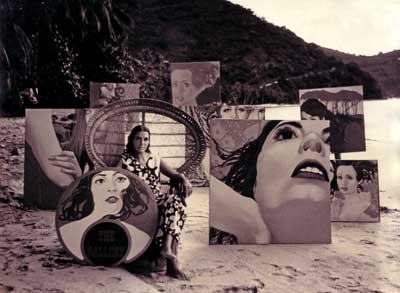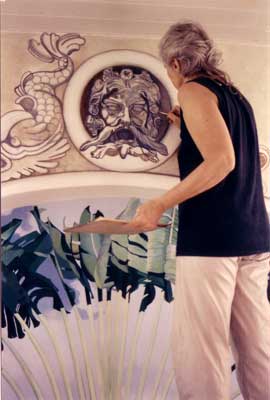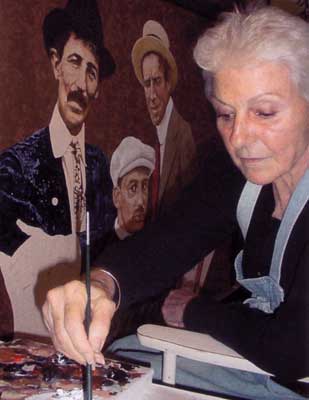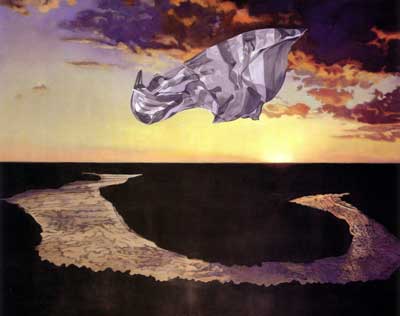|
MARIANN LOVELAND
BIOGRAPHY
Born in Ancon, Panama in 1932, I was first united with my father, an officer in
the United States Navy, when I was four months old. From that point on my mother
and I followed him around the globe to various tours of duty in ports and bases
located in the mainland United States, Panama and Honolulu. This lifestyle
continued through the war years up to his retirement in 1954. Children are
amazingly resilient; I soon adjusted, adapting to the vicissitudes of a life of
constant upheaval and change. My parents divorced when I was thirteen. The
courts decided that I should live with my father. I was given many wonderful
sensitive teachers, helpers of all sorts and grace. What could have destroyed me
was transformed into hard won insights and strengths that have served me well
and continue to do so.
I worked my way through undergraduate and graduate school obtaining a Master of
Fine Arts graduate degree from Cornell University in 1961. Coinciding with the
death of my father I relocated from Ithaca to New York City where I set up my
first painting studio in Greenwich Village above an Italian Restaurant on
Thompson Street. Concurrent with this move I had my first one- person exhibition
in a warehouse on the next street over called Washington Square Gallery. The
gallery director, Harry Cropper, had an innovative idea before its time. Just a
few years later warehouse galleries became a trend in the So Ho district.
In 1963 I began a rewarding teaching career that has taken me to some
interesting institutions including Cornell University, University of Cincinnati,
University of Tulsa, University of Alaska – Fairbanks and the Savannah College
of Art and Design. Traveling is still in my blood. Throughout the years
that I taught I worked in my studio after hours, during which time I exhibited
my paintings, collages and drawings nationally and internationally. On a
tropical island named Tortola, British Virgin Islands, where I also lived and
worked from 1967 to 1977 I operated an art gallery and taught art to the local
population.
In the 1950’s during my formative years as an undergraduate painter at Ohio
State University I had the great fortune to study painting under Professor Hoyt
Sherman. After my first year, as an experiment, he took two promising students
out of their undergraduate painting classes to work in a more advanced graduate
environment. I was given a space in the graduate studios where I had my own key
and could work any time day or night. Professor Sherman was allergic to fumes
from oil paint. Consequently his students made their own water-soluble paints
using dried pigments that were ground and combined with a liquid medium called
PVA (Polly Vinyl Acetate). This medium was an early version of what later became
acrylic paints. Leonard Bocoer occasionally visited our painting studios as he
was a friend of my painting teacher. He became interested in our PVA paints
resulting in his creating “Magna” the first line of acrylic paints for artists.
In 1961, during my second and final year as a graduate painting student in the
College of Architecture at Cornell University, I submitted two paintings to a
juried exhibition at the Roberson Memorial Center in Binghamton, New York. The
jury, consisting of Albert Christ-Janer, who was then Dean of the Pratt
Institute Art School, and Arnold Blanch of Woodstock, New York, awarded first
prize and purchase award to two of my paintings. Subsequently, both artists
contacted me asking for slides of my work, and they were most generous in their
support. They showed my paintings to their art dealer at Krasner Gallery in New
York City. I was invited to join the stable of artists during which time I was
in group exhibitions and eventually had a solo exhibition in 1965.
Upon receiving my graduate degree of Master of Fine Arts in 1962, I moved to New
York City. I had a dream of finding a studio space in the heart of Greenwich
Village, and after walking through various areas I eventually located a storage
room above the Grand Ticino Restaurant on Thompson Street, one block below
Washington Square. During those early years I got small jobs modeling for covers
of a pulp fiction magazine called Manhunt. Occasionally my gallery sold my
paintings. Every day, on my way to my studio by way of the restaurant kitchen, a
generous cook would hand me two hot plates of food—for me and my dog.
Two years later I returned to Ithaca and Cornell University to teach drawing and
design full time in the Department of Housing and Design from 1963 to 1967. I
continued to paint figuratively and exhibited my work locally, in Evansville,
Indiana, and in New York galleries. By that time the artistic focus had shifted
away from abstract expressionism. An earlier figurative show at the Modern in
New York City established that there were some powerful modern artists who
painted figurative works. I was encouraged to discover that I was not alone. The
commitment to my vision was unwavering. However, it was not until I left my
tenured teaching position in 1967 and moved to Tortola, British Virgin Islands,
that I believe I was finally able to paint that vision.

  |
Cane Garden Bay, Tortola, British Virgin Islands
 |
A year later I married an architect on the island and had the luxury of being
able to fully commit all of my time and energy to my work. Concurrently, with
assembling a body of strong work that gradually moved through a transition from
stylized to highly realistic figures, I had the good fortune to meet Robert
Stefanotti. At the time he was the Director of Gampel Weitzenhoffer in New York
City. He showed my work in a Director’s Choice exhibition. Shortly thereafter he
opened his own gallery on 57th Street and asked me to join his stable of
artists. I found myself among artists like Malcolm Moreley, Howard Kanowitz, Guy
Johnson, and Lowell Nesbitt. There were exciting, heady years of expansion and
discovery. My work received critical review and recognition.
My eleven year marriage ended in 1978 and once again I returned to live in
Ithaca, New York. At that juncture, the sales of my work provided me with money
for living expenses and to buy artist’s supplies. I was thus able to continue to
devote my energies only to painting. Having sold an entire solo exhibition at
Galeria de las Americas in San Juan, Puerto Rico, earlier in 1976, I set aside
enough money to buy a third floor loft for $15,000, in an artist’s cooperative
building down on Rivington Street just off the Bowery in New York City. Having
invested almost all of my available cash into my new home and studio, I found it
difficult to survive financially in the city. I augmented my rapidly dwindling
funds by bartering my work for services such as dentistry, and I took a part
time job creating color variations of fabric designs. By then my paintings were
no longer selling as they had done earlier. This was a very difficult period to
adjust to, when my career faltered and my work was no longer being recognized.
However, I continued to believe in my work; in fact, it became a life-line
through those hard times. Finally, during the early 1980’s I sublet my loft and
returned to a part-time teaching job as an Adjunct Professor in my old
department at Cornell University.


 |
Painting mural in Tortola, BVI
 |
In 1982, while teaching and painting in Ithaca, Tom Leavitt, the Director of the
Johnson Museum in Ithaca, New York, gave me a twenty year retrospective
exhibition of my paintings. This exhibition included several key pieces I had
painted since receiving my MFA degree twenty years earlier. What a wonderful
opportunity and learning experience it was for me to be able to borrow back
pivotal works from my past and assemble so many years of painting into one
exhibition. For me they became signposts pointing the way, and I embarked upon a
kind of spiritual journey into twenty years of my own past. Now, having severed
the umbilical cord that connected me to this body of work, I was enabled to see
it as if for the first time. Until then I hadn’t realized that I was, and
continue to be, so intimately and psychically connected to the imagery I chose
to paint. Drawn irresistibly to beauty and to the mystical dimension of life, my
challenge has been to look for the extraordinary within the ordinary. Light and
symbol became my means. It was like viewing a photo album of my past, its joys
and its sorrows. My earlier canvases isolated the figures, sometimes placing
them upon flat patterned backgrounds; there was little relationship between the
two. In 1972 the major change took place when I was working with the painter
John Clarke assisting him in setting up photographs for him to work from that I
started taking photographs for my own paintings. The early photographic canvases
still used a flat ground; however, that quickly changed when I took my models
out into the beautiful beaches and interior areas of Tortola, British Virgin
Islands. Light and shadow began to move across layered planes moving back into
deep spaces. No longer static, my paintings incorporated movement as an
important consideration, where a moment, a slice of life, was frozen in time and
space. My painted figures, and my personal life, struggled within restrictive
ropes that held them. The ropes metamorphosed into organic vines and movement
increased; eventually, the figures broke forth into the freedom reflected in
bellows of cloth caught by the wind. I painted those canvases when I had decided
to leave the restrictive life on a small island and my marriage.


 |
Working on the 60 foot exterior mural
for the History Center in Ithaca, NY
 |
My teaching positions expanded taking me farther a field to Cincinnati, Ohio;
Tulsa, Oklahoma; and Fairbanks, Alaska. Along with my full-time teaching
responsibilities I continued to maintain a studio, pursue my painting, and
exhibit my work at Tibor de Nagy Gallery.
In 1978 I was commissioned to paint my first mural in a large
private estate in Tortola, British Virgin Islands. Each year, for one month, I
returned to the island in February to paint a series of murals, which now extend
throughout the client’s home. It was during the first mural commission that I
met an Englishman who became my husband a year later. We married and settled
into my loft in New York City and worked on its restoration over a three year
period getting it ready for sale. We invested the proceeds into a Victorian
house in Ithaca, New York. With the exception of a brief three month contract in
1994 to teach in the Savannah College of Art and Design (a job I got through my
old friend Robert Stefanotti), which took us to Savannah, Georgia, I was again
in the position of being able to devote myself entirely to my art work.
Watch a video of a lecture given at
Savannah College of Art and Design.
In 2003 I received a special recognition award from The Rotary Club of Ithaca
and the City of Ithaca for a 60
foot exterior mural for the History Center. Watch a video of the creation of the "Looking Out From History" mural.

 |
Nightsail, oil on canvas, 48' x 60'
 |
In 1993 I had a second museum exhibition of my paintings. This time it was held
in New York City at the Nicholas Roerich Museum. Upon my stepmother’s death, I
was left a small inheritance, which I invested into designing and publishing a
color catalogue for the exhibition. Approximately a decade after my first museum
exhibition at the Johnson I was again given the opportunity to encounter my
work. Always having a leaning toward surrealism, the paintings moved away from
photorealism. Released from the restrictions of what I can set up and
photograph, my figures were no longer tethered; many lift off into space and
move into other dimensions to explore felt but unseen universes. As I frequently
experienced, when I mount an exhibition of a large body of work, I had a sense
of closure. This was freeing; I felt released to move on into new areas of
exploration.
My very first canvas was figurative, and with a few exceptions, I have continued
to explore the endless potential and the challenges of figurative painting
throughout my career . In those student years, when a model wasn’t available, I
used mirrors, snapshots, anatomical reproductions, and reproductions of
paintings to assist me. The Old Masters, notably La Tour, Botticelli, Vermeer
and Rembrandt, have continued to influence my work. What captivates and inspires
me the most is their ability to capture light and touch the soul with beauty.
Reproductions of Blake, de Chavannes, and Redon first introduced me to the power
of symbolism. Symbolism has its roots in everyday experience and is meditative
to the mind as it provides a focus for the imagination. It is an idea that has
the ability to reflect universal qualities that transcend language or pictorial
representation. Tangible areas of the inner world have reflections in the matrix
of symbols, and access deeper nuances of insight. It was during an exhibition of
my paintings in 1970, at the Piccadilly Gallery in London, England, that the
Director, Godfrey Pilkington, first referred to me as a “symbolist.” Later I was
called a “photorealist,” as I had begun to work realistically from my own
photographs. Gregory Battcock, in his book Super Realism, referred to me as a
“super realist.” However, he did note that my work deviated from the norm in
that it reflected meaning. More than the title of photorealist or super realist,
I feel that symbolist continues to be the best category for me and reflects what
my work is about.
In 2008 I designed and printed a second color catalogue of my work that
accompanied a mobile exhibition that traveled to Tortola, British Virgin
Islands. Working closely with a printer we translated all the paintings into ink
jet images on canvas that did not exceed 36” in the longest dimension. The
exhibition was transported by air as accompanying luggage in the form of four
40” x 32” x 12” crates of stretched and framed works ready to install.
As in the past this retrospective show, chosen from works I have painted since
departing from the islands thirty years ago, has given me an overview of where
my work has taken me.
At this juncture I am experimenting with extracting sections of older works and
placing them within new contexts. As I explore these pictorial possibilities I
seek the illusive qualities of mystery, light, and the pursuit of beauty that
informs the soul.
|
![]()

![]()
![]()
![]()
![]()

![]()
![]()
![]()

![]()
![]()

![]()